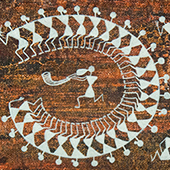India has a rich tradition of folk arts, the custodians of which are the many tribes settled in the interiors of our Indian states. Warli paintings are one such precious tribal art originating in the state of Maharashtra. According to historians, the practice of Warli tradition traces back to the Neolithic period of 2,500 BC to 3,000 BC. Then traveling across borders and territories, it has now emerged as a well-known art with great demand in the international market as well. The Warli tribe is believed to initially express the style over the walls of their houses, then slowly developing it to be executed on paper and cloths. Anciently, this means was used for transmitting folklore to a populace not acquainted with the written word. The most important aspect of the painting is that it does not depict mythological characters or deities but the social life of human beings and their connection with animals around them.
This painting resembling prehistoric cave paintings, shares similarities with the mural paintings from the Bhimbetka rock shelters of Madhya Pradesh, built in 500 and 10,000 BC. Along with scenes of human figures engaged in activities like hunting, sowing, and harvesting, festivals and celebrations also enjoy an important place in the art, showcasing the simple and humble life of the Warli tribe. Here people and animals are represented by two inverse triangles; the upper triangle forms the upper body while the lower triangle is for the pelvis. Gender difference is marked with a difference in their hairstyle and triangle sizes; the larger triangle at the top is for men and the broader lower triangle for women. These rhythmic patterns are often made on village hut walls that are made of natural elements like tree branches, mud, and cow dung, which becomes a red ochre background for the paintings. A distinctive feature is that Warli paintings are only done with a white pigment made from a mixture of rice paste, water, and natural gum added as a binder, unlike other folk paintings. Here the artist creates a paintbrush out of a bamboo stick by chewing its one end to gain an intended texture. Though traditional methods included contrast of white over earthy colours, contemporary formats have modified it to include rusty vibrant colours. The modern Warli art comprises abstract and representations of new objects such as bicycles, transistors, hand pipes, horses, etc., in corners of the paintings. The Warli tribes lead a simple and humble lifestyle that reflects strongly in their crafts. Though traditionally forest-dwellers, they have now emerged a pastoral community.
They now reside on the west coast of Northern Maharashtra, with a higher concentration in the Thane district, off Mumbai. Though they belong to an economically weaker populace, they still wholeheartedly hold close to their indigenous customs and traditions than leaving it to despair. The commercialization of Warli paintings is the next hope for the upliftment of the community. Fortunately, it’s been proving positive for decades with the heightened popularity and demand in both the national and international markets. Therefore, they are increasingly becoming integrated with the mainstream.
The Theme of Warli Art:
(A) Colours and shades - The Warli paintings are done on a stiff mud base using white colour, made out of finely grounded rice. Sometimes, the art also incorporates occasional dots in red and yellow colour. Historically, i.e., in its most authentic stage, ingredients like henna, indigo, ochre, charcoal, mud, brick, etc., were used to produce colours. Still, nowadays, artisans are found to use acrylic or fabric paints, easily available in the market.
(B) Content of the art - This extremely rudimentary art includes basic geometric shapes like circles, triangles, and squares. The circle mostly represents celestial bodies like the sun and the moon. The triangle forms a living being body, mountains, and certain trees, while the square is used to depict a sacred enclosure or a piece of land. Hence in every painting, all the elements are found to be within a square, and the representation of Palaghata, the goddess of fertility is a regular view.
(C) Value of Warli art - The sense of uniformity and the close social interactions with nature and the spirits are what make the essence of Warli paintings. In Tribal culture, death is not an end but is the dawn of a new beginning, thus considering life as an eternal circle. Hence, we find much representation of circles in tribal art. The origin of the art is closely related to the ancient beliefs of following an artistic ritual to invoke preeminent power, get rid of, or protect against diseases and natural calamities. The art of the Tribal people symbolizes man's harmony with each other and with nature.
Creative Craft Center from Nagpur is a place where training is given for artists to learn different kinds of art. Mrs. Vaishali H. Kawre is the owner cum trainer of this center. She runs this center for the last 22 years.




